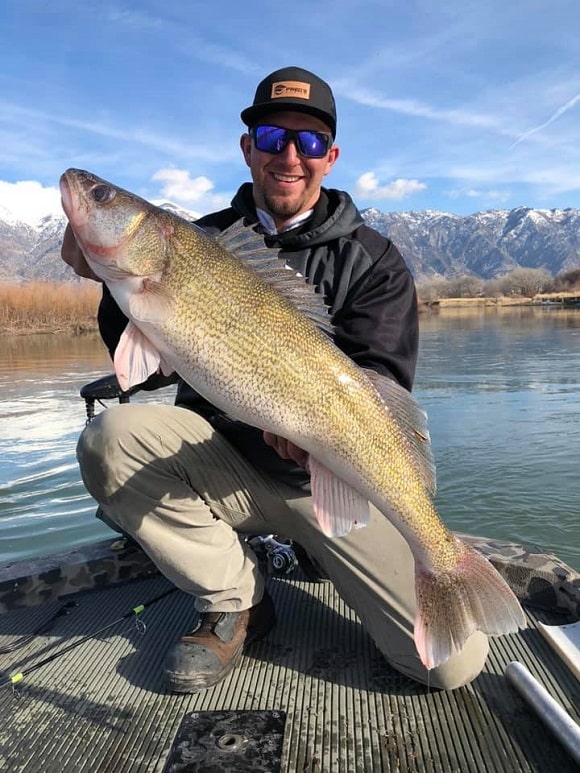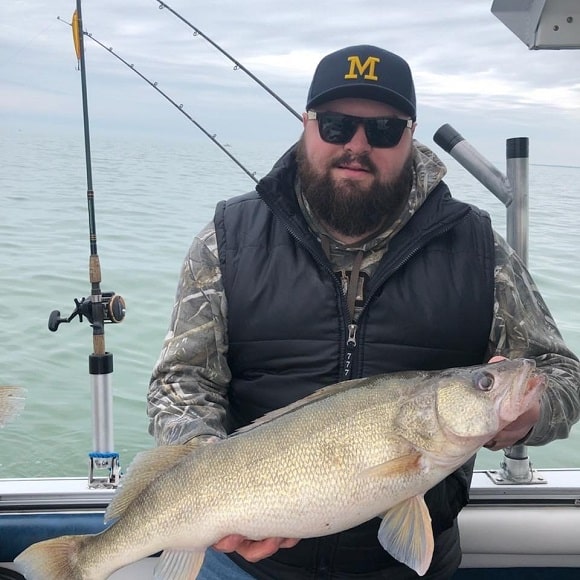Featured image courtesy of A A Ron Phillipe
The walleye is one of North America’s most popular game fish and a highly interesting fish species.
The name “walleye” has always intrigued me, and so have its many nicknames. So, I decided to do some research and find out everything I could about the walleye’s various names.
I did find some really cool, and to me, hitherto new facts, and I really hope you’ll find them as interesting and eye-opening as I did!
Let’s get right to it then, shall we?
PRO TIP: Need new gear for the upcoming walleye season? Then check out this quality equipment on Amazon.
It’s very cost-effective, durable, and will get the job done every time!
Where Does the Walleye Get Its Name From?

Courtesy of Jake Hammer
Alright, so let’s start with the origin of the name “walleye.”
The walleye’s Latin name is Sander vitreus. Sander is a genus of predatory ray-finned fish in the family Percidae, the wider perch family.
The Latin word “vitreus” means “like glass” or “glassy” and refers to the walleye’s particular set of eyes.
Walleyes have eyes with a reflective layer of pigment called the tapetum lucidum.
This is a really cool natural light reflector system that enhances the fish’s vision and helps it see at low light levels and at night. In addition, the layer makes the walleye’s eyes appear opaque as if they weren’t transparent.
Much like, you guessed it: a wall! It’s a pretty accurate name if you think about it, isn’t it? The wall eye! Makes perfect sense if you ask me.
Their eyes are such a particular and noticeable feature of their body that they literally gave the fish its name!
Why Do Some Canadians Call Walleyes Pickerel?

Courtesy of Randy Trollinger
Okay, now we know why it’s called a walleye. So why do so many Canadians call them “pickerel”?
This is a really interesting debate, and it starkly reminds me of the steelhead vs. rainbow trout discussion in the US.
Well, not really, because we’re talking about two entirely different species in this case.
As mentioned above, the walleye is the biggest member of the Percidae, the perch family! Pickerel, on the other hand, refers to several species of small pike in the genus Esox.
These species include the chain pickerel (Esox niger), the grass pickerel (Esox americanus), and the redfin pickerel (Esox americanus americanus).
Despite the clear taxonomic difference, the name “pickerel” has stuck in Canada and is sometimes used interchangeably with walleye.
This usage likely dates back to early settlers and anglers, who may have used the term loosely to describe various types of predatory fish in the region.
Over time, the name persisted, and now it’s a regional vernacular that’s firmly entrenched in Canadian fishing culture.
However, from all I’ve heard, not all that many Canadians call walleyes pickerel!
A big survey I ran in a few very big Canadian fishing groups on Facebook revealed that only about 30% of Canadians use the term pickerel to describe walleyes.
And personally, I don’t think it’s such a big deal! Local and regional cultures form and develop differently, and some of the old ways and names have stood the test of time.
And why not? There are worse things to get upset about if you ask me.
Are There Other Names for Walleye?

Courtesy of Matt White
Yes, indeed! Walleyes go by several other names depending on where you are in North America.
In addition to “walleye” and “pickerel,” they are sometimes referred to as “yellow pike” or “yellow pickerel.”
In some Indigenous cultures, the walleye is called “ogaawag.”
This name, along with its cultural significance, highlights the importance of the walleye in the diets and traditions of indigenous peoples in the regions where the fish is native.
The term “ogaawag” (also spelled “ogaa” or “ogaas” in various dialects) comes from the Ojibwe language, spoken by the Ojibwe (also known as Chippewa) people, one of the largest Native American tribes in North America, whose homeland covers much of the Great Lakes region.
“Ogaawag” specifically refers to the walleye, reflecting its prominence in the tribe’s fishing practices and culinary traditions.
For the Ojibwe, walleye is not just a food source but also a part of their cultural heritage, often featured in traditional stories, ceremonies, and sustenance practices.
The Ojibwe deeply respect the natural world, and their names for various species often reflect a profound understanding and relationship with their environment.
The use of the term “ogaawag” for walleye is a testament to the fish’s role in the ecosystem and its value to the Ojibwe people.
Are Walleye and Pike Related?
While walleye and pike are both popular sport fish and share some superficial similarities, they are not closely related.
As previously mentioned, walleye belong to the Percidae family, which includes perches and darters. Pike, on the other hand, belong to the Esocidae family.
The confusion often arises because both fish are predatory, have elongated bodies, and are found in similar habitats across North America.
However, they are quite different in terms of behavior, diet, ecological niches, and size.
Differences in Size
One of the notable differences between walleyes and northern pike is their size.
Walleye:
- Average Size: On average, walleyes measure 10 to 20 inches and weigh between 1 and 3 pounds.
- Maximum Size: The largest walleyes can reach lengths of over 30 inches and weigh up to 20 pounds, although such sizes are rare. The current world record for walleye stands at 25 pounds and was caught in Tennessee in 1960.
Northern Pike:
- Average Size: Northern pike generally range from 20 to 35 inches in length and weigh between 4 and 10 pounds.
- Maximum Size: Northern pike can grow much larger than walleyes. They can reach lengths of over 40 inches and weigh up to 25 pounds. In some exceptional cases, northern pike can grow even bigger, with the current world record being a massive 55-pound fish caught in Germany in 1986.
These size differences are significant for anglers, as they often influence the type of tackle used and the fishing techniques employed.
While walleyes are prized for their delicate flavor and challenging catch, northern pike are known for their aggressive strikes and formidable fight, making them a thrilling catch for sport fishermen.
Essential Gear Tips
If you’re looking for solid and reliable walleye fishing gear, these tips might be useful for you.
This gear and tackle is of top quality and sells at a very decent price on Amazon:
Ugly Stik GX2 Medium 6’6” Spinning Rod
A solid and popular all-round spinning rod! The Ulgy Stick is lightweight, has great sensitivity, and phenomenal action. Fits both beginners and seasoned anglers. A 6’6” or 7′ Medium rod is your best pick for walleyes.
Pflueger President 30 Spinning Reel
An affordable high-performance spinning reel that’s perfect for walleye. Pflueger spells high quality and awesome durability! Makes for a great combo together with Ugly Stick. A Size 30 or 35 is a solid choice for walleye!
Power Pro Braid
One of the best braids available today! Zero stretch, great feel, and immense strength make this line the perfect pick for walleye in both open and snaggy waters. Put on a 10 to 20 lb test, and you’re good to go!
More Walleye Articles
The post So Why Are Walleyes Called Walleyes? appeared first on Strike and Catch.
https://strikeandcatch.com/why-are-walleyes-called-walleyes/
 CampingSurvivalistHuntingFishingExploringHikingPrivacy PolicyTerms And Conditions
CampingSurvivalistHuntingFishingExploringHikingPrivacy PolicyTerms And Conditions
